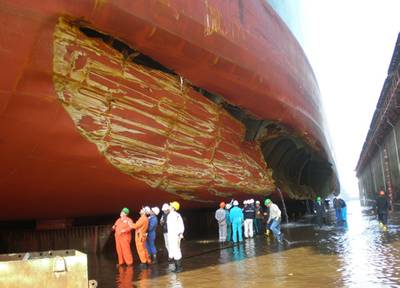Double Hulls and the Oil Spills That Never Happened
When it comes to marine pollution, often it’s the bad news that makes the headlines. But for every newsworthy incident, there’s another story about the spills and other incidents that didn’t happen thanks to preventative measures and policies, and the responders who think quickly on their feet. In this new blog series, we’re shining a spotlight on the “good news” stories.
Looking for a good news story? How about this one: “No spill reported after tug strikes oil tanker in Valdez.” But why is there a story about a spill not happening?
We hope, and most people assume, that oil should stay on the ship, but every time we transport oil, whether by truck, barge, pipeline, or tanker, there is a risk of spills. And this risk is especially evident in Valdez and Prince William Sound, the southern terminus of the trans Alaskan Pipeline and the site of the 1989 Exxon Valdez oil spill.
Responders know that once oil is spilled, there are no good outcomes. Keeping oil from spilling is the best way to go, and that's why the Oil Pollution Act, passed after the Exxon Valdez spill, has a huge emphasis on safety and prevention. This law has had a dramatic impact in reducing tanker accidents in U.S. waters and worldwide.
But accidents still happen. Machinery can fail, humans can make errors. So what happened this time? On Jan. 11, 2021, the tanker Polar Endeavour was fully loaded and readying to depart the Valdez Marine Terminal. One of the tugboats assisting with the departure, the Courageous, lost control and struck the tanker. One crew member on the tugboat was injured, but no oil was spilled and the accident is now under investigation by the U.S. Coast Guard.
What makes this a good news story is that despite having an accident, the safety regulations enacted after the Exxon Valdez helped to prevent a potential major spill. The collision caused a 4-foot indentation and tear in the tanker’s hull, but no oil was spilled.
How can that be? Well, when Congress enacted the Oil Pollution Act back in 1990, the legislation required that all tankers be double-hulled by the year 2015. Over time, all older single hulled vessels (like the Exxon Valdez) were retired and all new tankers were built with a double-hull structure, including the 900-foot Polar Endeavor, which was launched in 2001.
The hole in the side of the tanker penetrated the outer hull, but not the inner hull. The tanker underwent repairs and after an inspection, the U.S. Coast Guard cleared it to return to sea.
A collision with a tanker is never a good thing, and double-hulls don’t eliminate all risks, but the double-hull design of the Polar Endeavor prevented a bad day from getting potentially a lot worse.
NOAA’s “Non-Response”
In this case, the NOAA team was not needed but we do respond to a lot of potential spills. We often are requested to generate a hypothetical or “what if” oil spill trajectory and potential resources at risk for grounded and damaged vessels, even if they aren’t leaking. This helps the Coast Guard plan ahead in case the incident becomes more severe.
The author
Doug Helton is Regional Operations Supervisor, NOAA Emergency Response Division.













